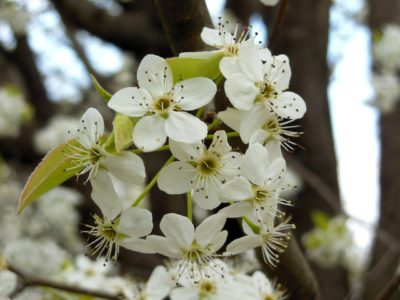These trees are a beautiful, common sight in St. Louis: Thousands of white flowering trees that bloom early in the spring and symmetrical, eye-pleasing canopies and glossy green leaves.
But beauty isn’t everything and it is even dangerous.

Bradford pears, or the Callery pear, originated in China and were brought to the U.S. to help save the pear industry by grafting pieces of the tree onto pear trees, resulting in a hybridization that was resistant to common fruiting pear diseases.
The public fell in love with them for their disease resistance, quick growth, beautiful early blooms, ability to be planted in diverse locations, and symmetrical canopy.
Now, this tree is a scourge in Missouri and across the United States.
Bradford Pears Smell Terrible
One of the biggest complaints people have against the Bradford pear is their smell. They smell terrible, akin to rotting flesh. No one wants to sit outside on a nice spring day and have to hold their nose with a Bradford pear nearby!
This smell, like other plants, is used to attract pollinators, and the offensive odor of the Bradford pear is caused by two chemicals known as trimethylamine and dimethylamine. So if you wonder what smells like a rotting animal, smelly armpits, or dead fish, you now know to blame this tree.
Bradford Pears Are Prone To Breakage & Splitting
Another reason to reject the Bradford pear is that they are dangerously prone to breakage and splitting. This is thanks to their weak crotches, which causes the Bradford pear to break under its own weight.
As a home or business owner, it is your duty of care to ensure that the trees on your property are safe. If a limb breaks off and injures someone or damages property, you will be responsible if you knew the tree was prone to breakage and did not take measures to correct the problem.
In fact, there is simply no good way to prune these trees to remove compromised limbs and retain that shape people fell in love with.
Bradford Pears Choke Out Native Species
Most critically of all, the invasive Bradford pear threatens native Missouri species. According to the Missouri Invasive Plant Task Force (MoIP), “When non-native Callery pear cultivars cross pollinate, the hybrid offspring become invasive, meaning they are aggressive trees whose presence causes or is likely to cause economic harm, environmental harm, or harm to human health.”
These hybrid trees then rapidly spread, choking out native species. And because Bradford pears and their offspring bloom early, they prevent native flowers and plants below from getting the sun they need and blooming, preventing the attraction of essential insects like bees and butterflies.
Without this native ecosystem that Missouri plants and animals have adapted to over the millennia species can decline, leading to less biodiversity. In turn, less biodiversity means a lowered quality of life for not only plants and animals, but humans.
Reject The Bradford Pear: Plant Native Trees Instead
At Hansen’s we always encourage customers to consider removal rather than pruning their Bradford (Callery) pears. Plant these native alternatives to the Bradford Pear instead:
- Serviceberry
- Eastern redbud
- Flowering dogwood
- Hawthorn
- Crabapple
If you live in Missouri, there are programs available that will provide you with a free native replacement tree when you cut down your Bradford pear.
Remember to always hire a professional tree care service like Hansen’s to remove your trees. Our professionals are highly trained and insured to safely get the job done.
